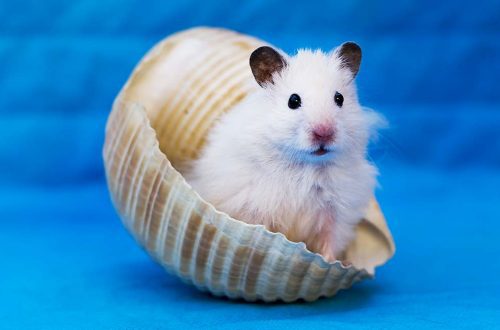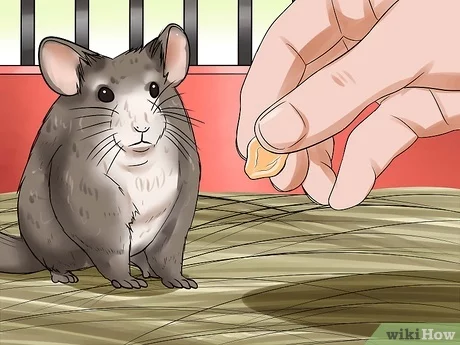
How to tame a chinchilla to your hands and make friends with her
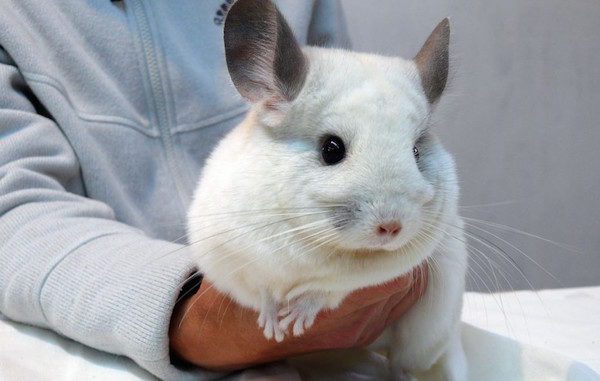
Chinchillas are considered to be intelligent rodents with excellent memories that can be easily tamed at any age. To understand how to teach a chinchilla to your hands, you need to take into account the recommendations of experienced breeders and be ready to devote time and attention to your pet every day. These rodents are quite shy and cautious, and also have individual characters, which affects the choice of the right approach to establish friendly relations with them.
Contents
Why chinchillas
These funny pets have their own unique features and characteristics, which distinguishes them from other rodents. The advantages of chinchillas include:
- pleasant external data;
- absence of unpleasant odor;
- gentleness and gullibility;
- relative ease in taming;
- the absence of allergic reactions to wool and the excretion of animals in allergic people;
- self-sufficiency of pets: they rarely worry about loneliness, they are able to remain unattended for a couple of days if there is enough food and water in the cage;
- no need to vaccinate animals.
They rarely get sick if the owners follow the rules of hygiene when leaving.
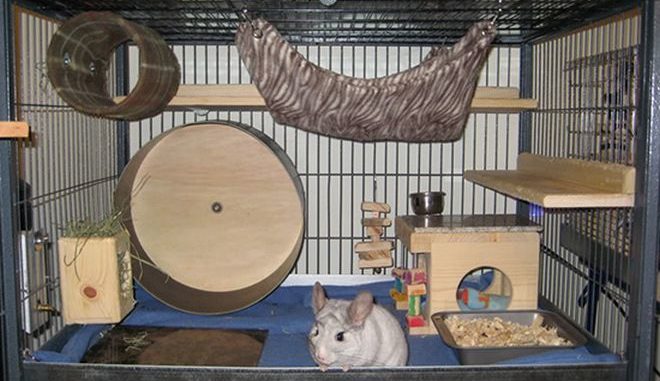
But there are some features that you should know about in advance when choosing this pet:
- intolerance to high levels of humidity and heat. If the air temperature exceeds 30 degrees, there is a threat of heat stroke, which sometimes leads to the death of the animal;
- the need for regular intake of “dust baths”.
It is not necessary to wash the animal in water. Due to the increased hygroscopicity of the delicate chinchilla fur, its cage must be equipped with a bathing suit – a container with dry sand, which will help the animal keep its fur clean and dry. The sand intended for this procedure is purchased at a pet store. Also, in order to prevent the appearance of fungal diseases on the skin of a pet, an antifungal drug must be added to the sand once every 1 days.
Chinchilla adaptation after purchase
An abrupt change of habitat, the appearance of strangers nearby cause stress in any animal. You can help your pet adapt to a new home faster if you follow these simple guidelines:
- To avoid fear in the animal, try to move slowly when you approach his cage. Do not make noise, all your movements should be smooth;
- often talk affectionately and calmly with your pet, stay close to the cage. So the animal will quickly remember and get used to you;
- you don’t need to immediately try to pick up a chinchilla, she needs to first get used to a new place, get used to the smells, sounds, daily routine and room;
- if the animal stops hiding at your approach, try to carefully and slowly open the cage door and bring a treat to the pet in an open palm.
A tidbit for a rodent will be raisins, nuts or a small amount of seeds. Don’t expect him to take the treat right away. But curiosity is one of the main characteristic features of a chinchilla, therefore, with due patience and with the right approach, they begin to treat themselves from the hands of the new owner after 7-14 days. You should not try to grab the animal by the scruff of the neck or pick it up after feeding, as such actions will frighten him and cause an aggressive reaction in response. Repeat daily attempts to treat the chinchilla during its most active hours, preferably after 18 pm.

Important! Take advantage of experienced breeders. Start alerting your pet to your arrival by making soft sounds like clicking your tongue. Thus, after a while, the rodent will know who is approaching it, and will begin to react more calmly to you.
How to make friends with a chinchilla
It is easier to make friends with a young individual than with an adult who has already visited other owners. Especially if the former owners treated the pet with insufficient attention, neglecting the rules of care and maintenance at home. If you plan to earn the trust of the animal and tame it, it will not be possible to do this in 5 minutes, be patient. It can take from a couple of months to several years to tame some chinchillas that have suffered physically and morally at the hands of previous owners.
To understand if your pet is afraid of you, watch him. Signs of fear in an animal are manifested as follows:
- the animal always carefully monitors your movements and actions;
- wakes up instantly and can take a protective stance when he hears someone approaching;
- barks, snorts, sometimes tries to get urine into you;
- trembling, nervous, trying to bite when trying to pick him up;
- his hair is peeling off, in some places to the bald patches.
If your goal is a friendly, trusting relationship with your pet, don’t try to speed things up.
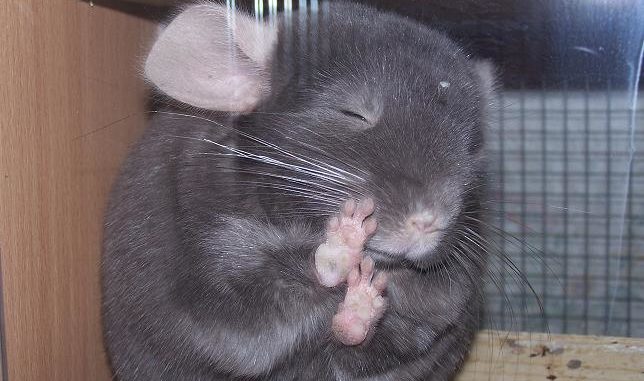
Your pet is smart enough and has a good memory to remember both positive and negative situations that happen to him for a long time.
Ways to build friendships with a chinchilla
The main steps to help tame a chinchilla:
- Place the cage in a room where it is not too noisy.
- After you place the animal in a new cage, attract his attention and treat him with a nut or a raisin. Do not thoroughly feed or touch the pet for the first time, let him get comfortable and get used to it. Note that treats such as raisins should not be given often.
- Speak quietly and kindly to the chinchilla while standing near the cage. Try to treat her with a leaf or a blade of grass through the bars of the cage. Even if she doesn’t take the food right away, try again after a while. When the chinchilla accepts the treat, it will have pleasant associations with your hands giving something delicious.
- When the animal reacts calmly to your actions, try to open the cage, then carefully place your hand on the bottom of the cage. If your pet is frightened or alert, remove your hand. While it is worth continuing to communicate with him only at the level of conversations. The next day, try again to bring your hand closer to the pet inside the cage, carefully observing his reaction. Sooner or later, curiosity and trust will win, the chinchilla will decide to come up to the hand to sniff and explore it. She may taste it slightly or even jump into her palm.
- If the animal’s reaction to you is aggressive, there are signs of a strong fright, do not disturb him. It is better to move away from the cage and give the rodent time to calm down.
- If the animal is nervous and has not yet had time to fully adapt to a new place, do not let it out of the cage. Otherwise, in the wild, the nervousness of the animal will increase, and it will be problematic to return it back to the cage.
Important! If the chinchilla does not respond to long and regular attempts to tame it, try to take it calmly. A chinchilla, like a person, can have an independent “loner” character.

Consider also the fact that each animal has an individual character, respectively, the conditions, approach and time of taming rodents are different. The main thing is not to give up trying to make friends and not give up, then the likelihood of success in the emergence of friendship will be much greater.
How to pet a chinchilla
If the adaptation stage is successful, the pet trusts you and takes a treat from your hands, you can try to establish tactile contact with the baby. The following recommendations will help you:
- For starters, if the rodent is already taking a treat from your palm, try gently scratching it under the chin. Do not be discouraged if the attempt fails immediately and the animal runs away from affection. Over time, he will feel safe and let you pet him.
- Do not rush to remove your hand immediately after the treat, let the baby sit and eat the grain right in the palm of your hand. The longer the rodent sits on your hand, the greater its degree of trust in you. If the chinchilla does not go to the hands or immediately jumps from the palm of your hand, do not interfere with this, let him get used to the new owner.
- If the animal itself meets you at the door as soon as you open it, and feels comfortable in your palm, you can start stroking. Slowly put your hand in the cage, pointing your index finger towards the pet. When he approaches, gently touch his cheeks or chin, gently stroking his fur. Try not to touch the whiskers – this is a very sensitive ticklish area for most rodents. He may run away at first, but after a while he will come back, and you can resume your attempts to pet him.
- If the chinchilla calmly sits on your hand and allows you to stroke it, you can start stroking the chinchilla on the chest or on the back with your other hand. If he is nervous and does not give, do not touch him against his will, leave attempts to establish contact until the next day.
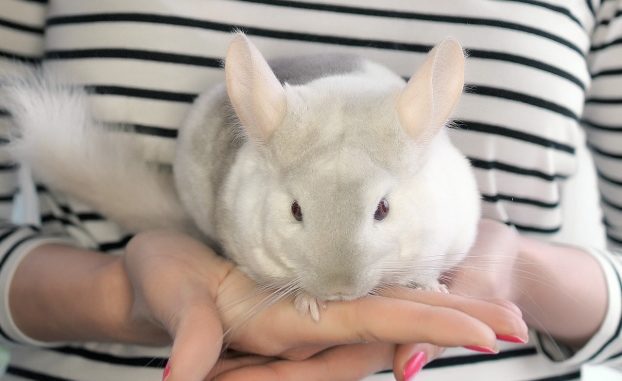
Important! Learn to stroke your pet properly. Never put your hand over the animal, this will greatly frighten him. Many chinchillas are instinctively afraid of such movements, which they associate with a predator rushing at them.
Remember that your goal is to make friends and establish trusting contact with the animal, not imposing your desires, but listening carefully to the responses of your pet. Always give him the opportunity to return to the cage and rest at the first sign of fright or excitement. Set aside time each day for calm and affectionate communication with your chinchilla, slowly moving towards building friendships with her.
Only after the animal has got used to you and is not afraid, you can try to move on to the next stage – training.
Video: how to tame a chinchilla
Teaching a chinchilla to your hands: learning to be friends with a pet
3.4 (67.5%) 8 votes





